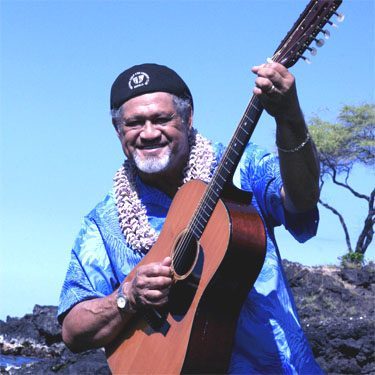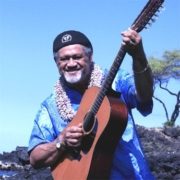CYRIL PAHINUI – HE’EIA
January-February 2008
ARTIST: CYRIL PAHINUI
TITLE: HE’EIA
LABEL: DANCING CAT
 The word He’eia refers to He’eia Bay on Hawai’i Island’s Kona coast, a place where King David Kalakaua used to enjoy on a day at the beach. In the opening musical selection of the same name, Cyril Pahinui evokes the setting with a powerful, lush interpretation of the name chant (mele inoa) for Kalakaua, with music attributed to J. Kalahiki. He’eia is one of three traditional songs for which he has created exquisite arrangements for slack key guitar.
The word He’eia refers to He’eia Bay on Hawai’i Island’s Kona coast, a place where King David Kalakaua used to enjoy on a day at the beach. In the opening musical selection of the same name, Cyril Pahinui evokes the setting with a powerful, lush interpretation of the name chant (mele inoa) for Kalakaua, with music attributed to J. Kalahiki. He’eia is one of three traditional songs for which he has created exquisite arrangements for slack key guitar.
One of the fascinating aspects of this third solo album is the way it showcases Cyril’s stylistic gifts. He plays an instrumental version of He’eia on Cut 1 with his 12-string guitar in the C Mauna Lua tuning (C-G-E-G-A-E). Later, in Cut 6, he plays it in Atta’s C Major (C-G-E-G-C-E), creating a different mood with the change in tonal coloration and adding his own vocals. Similarly he plays O Kamawailualani (the ancient name for the island of Kaui’i) on his six-string guitar in Cut 2 and uses his 12-string guitar for the same selection in Cut 10.
Many of the selections display Cyril’s sensitive use of rubato. The opening section of Makee ‘Ailana, a song celebrating one of the islands that used to dot the bay along Waikiki, has a plaintive, halting, singing quality that suggests a yearning for the beauty of the past. In Meleana E, he embellishes the opening with three finger rolls and slow chord progressions before launching into the ballad at a regular, slow tempo.
The CD also features an instrumental composed by Cyril Pahinui, titled simply Kiho ‘Alu (slack key). Its simple elegance has made it a standard frequently played by his contemporaries.
“The most important thing I did was to listen,” is the quote that Dancing Cat placed on the back cover of the He’eia CD jacket.. From the beauty and depth of his slack key guitar playing, it is evident that Cyril Pahinui has listened intently.
From his father, slack key guitar legend Gabby Pahinui, he absorbed the tunings, the rich ornamentation, and the soulful interpretations that set the standard for slack key playing for a generation. Jamming in the backyard or playing in the Gabby Pahinui Band, he was surrounded by Gabby’s gifted contemporaries, Atta Isaacs and Sonny Chillingworth, among others, who mentored him as he learned the art of kiho ‘alu. Cyril also learned to listen closely to the lyrics of the songs he interpreted, unlocking the kaona or hidden meaning and conveying its feeling instrumentally. Finally, he has listened to the stirrings in his own soul, translating personal experience and emotion into his interpretations of slack key standards and original compositions.
Four selections on He’eia feature Cyril Pahinui doing his own vocals. At first, I found these difficult to appreciate because his voice lacks the polish of his instrumentals. I found that it took a few listenings to realize that although Cyril’s voice may not conjure up Carnegie Hall, it perfectly suits the informality of a backyard jam session in the rural atmosphere where kiho ‘alu was born. Furthermore, when I heard him play in person, the soulful quality of his voice – so appropriate to the music and lyrics – more than compensated for the occasional edginess and l off-pitch moments in his vocals.
This year He’eia is a serious contender for the 2008 Grammy Award in the Hawaiian Music category and may break the two-year winning streak of the slack key compilation albums produced by Daniel Ho and George Kahumoku. Ironically, Cyril Pahinui is featured on this year’s compilation entry. In any case, if either of these two entries wins, the winner will be the tradition of slack key that musicians of Cyril Pahinui’s generation have lovingly nurtured for several decades.
Audrey Coleman is a writer, educator, and passionate explorer of world music and culture.













